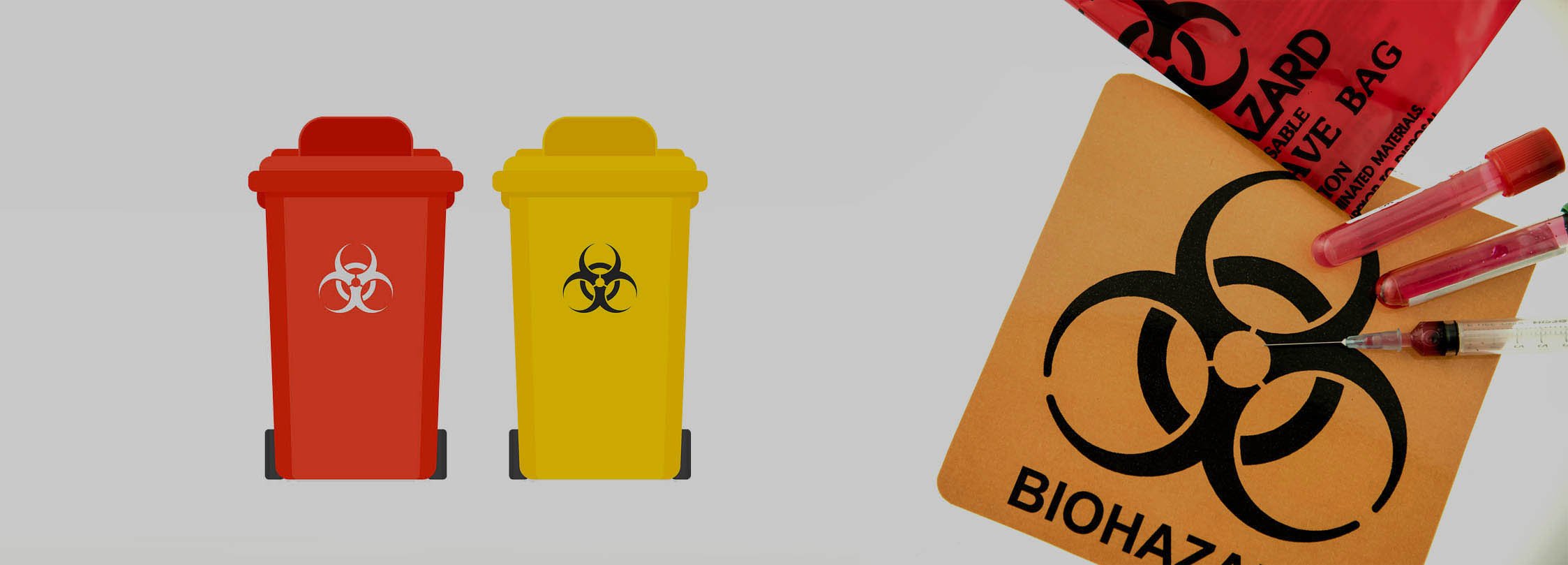
Biomedical waste types, definition and disposal management
- Why do we have to devote much more attention to the hazardous medical waste disposal? »
- Types of biomedical waste »
- Medical hazardous waste disposal and treatment technologies »
- Biomedical and hospital waste management: definition and purpose »
- How can the Celitron ISS (our own medical waste shredder) provide a solution for hazardous medical waste disposal? »
Waste produced in the healthcare sector may in significant part be considered as hazardous waste. The health and environmental risks caused by this waste can be well defined and the conditions for its management can be clearly separated from those of the waste generated in other areas.
1. Why do we have to devote much more attention to the hazardous medical waste disposal?
According to the position statement by the United Nations’ World Health Organization (WHO), in 2000 the improper treatment of medical waste (primarily the use of infected hypodermic needles and syringes) caused the following infections worldwide:
- hepatitis B: 21 million infections;
- hepatitis C: 2 million infections; and
- HIV: 260,000 infections.
The above figures show how relevant appropriate medical waste treatment is. According to the WHO directive,
hazardous waste should be processed as
near to its place of generation as possible. The risks involved in the transportation of
hazardous waste are large
and the risk factor found in some materials (e.g. those that are infectious) increases daily. Suitably located
and equipped
waste disposal facilities can minimize the need to transport hazardous materials.
(WHO publication, 2004)
A lot of the waste from hospitals is infectious biological material or objects, which although they are considered “communal” waste, are in fact contaminated. These latter items include textiles, bandages, syringes, and other objects exposed to infection through contact with patients.
Very much of the waste from hospitals is made up of special surgical instruments, such as surgical implants and other implements employed during operations. The disposal of medical waste poses numerous questions, the first of which is: How can medical waste be categorized?
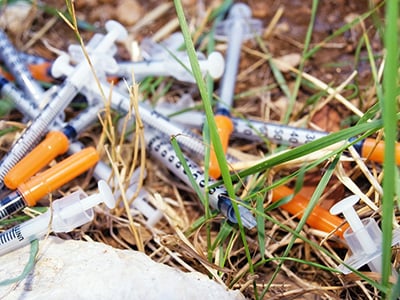
2. Types of biomedical waste
Infectious waste
Infectious waste is that which is suspected of containing pathogens (bacteria, viruses, parasites, or fungi) in a sufficiently large quantity or concentration to result in disease in susceptible hosts. This category includes:
- cultures and stocks of infectious agents from laboratories;
- waste from operations and autopsies on patients with infectious diseases (e.g. body tissues, and materials or
instruments having come into contact with blood or other body fluids);
- waste originating from infected patients in isolation wards (e.g. feces and urine, dressings from infected or surgical wounds, clothing that is heavily soiled with blood or other body fluids);
- waste having come into contact with infected hemodialysis patients (e.g. dialysis equipment such as tubing and filters, disposable towels, gloves, aprons, laboratory coats, and gowns);
- infected animals from laboratories.
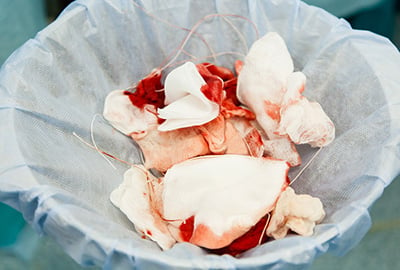
Pathological waste
Infectious materials containing dead tissue may conceal especially dangerous and/or communicable infectious agents. Such waste includes blood, body fluids, tissues, organs, body parts, human fetuses, and animal carcasses. A subcategory of pathological waste is anatomical waste, which consists of identifiable human or animal body parts, healthy or otherwise.
Sharps
Sharps are objects sharp enough to cut or puncture the skin, e.g. knives, scalpels and other blades, infusion sets, needles, hypodermic needles, saws, broken glass, nails, etc. They can transmit infections directly into the bloodstream. Sharps are generally treated as highly hazardous medical waste regardless of whether they are contaminated or not.
Regarding sharp waste, special consideration must be paid to: infusion, transfusion, and perfusion sets; butterfly needles; cannulas; disposable scalpel blades and razors; hemodialysis sets; laboratory slides; broken glass containers (bacteriological and clinical laboratories); ampoules containing solution residues, etc.
Two basic methods are used to tackle the risk of infection which sharps pose – reducing their infectiousness, or their sharpness. The first solution generally entails specifying methods of treatment for sharps, which are frequently as stringent as those applied to pathological waste. The second solution may entail the isolation of the sharps (typically in special containers), and their mechanical processing, or their encapsulation. Many states have thoroughgoing regulations regarding sharps containers, including measures to ensure their puncture-resistance and clear labelling. Certain states require sharps to be mechanically blunted or shredded, while others require them to be rendered unidentifiable.
3. Medical hazardous waste disposal and treatment technologies
Certain treatment solutions that diminish the risks of infection from medical waste and preclude scavenging may concurrently cause other health and environmental hazards. The incineration of certain kinds of medical waste, particularly those which contain heavy metals or chlorine, may release toxic substances into the atmosphere (due to, for example, insufficiently high incineration temperatures or the inadequate control of emissions).
Disposal of the waste by burial in landfill may cause the pollution of groundwater (if the site is inappropriately designed and/or managed). Because of the aforementioned hazards, when a treatment or disposal solution for medical waste is selected (especially when there is a risk of toxic emissions or other dangerous consequences), the relative risks and the integration of the method into the overall framework of a comprehensive waste strategy should be carefully evaluated taking local conditions into consideration.
Let us first examine the various technologies for medical waste disposal:
- Incineration
- Chemical disinfection
- Wet thermal treatment (steam sterilization)
- Microwave irradiation
- Land disposal
- Inertization
Incineration
Incineration was formerly the most popular method of disposing of the majority of hazardous medical waste. Although it remains a widely-used solution, alternative methods are growing in popularity. When selecting a treatment solution, various factors must be taken into consideration and many of these depend on local conditions, such as health and safety requirements, and the available options for the final disposal of the waste, etc.
The effectiveness of incineration is beyond doubt, yet the method entails serious issues concerning air quality. Due to the fact that the reagent is atmospheric oxygen, a large volume of air must continuously pass through the system. If the exhaust air does not pass through a control device, all substances that are volatile at the system’s operating temperature will be emitted with the exhaust stream.
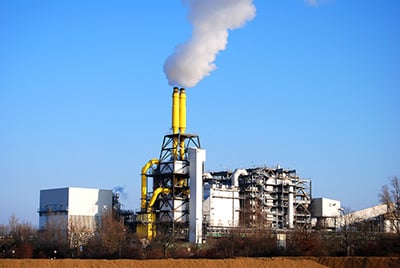
The disadvantages of incinerators are:
- The investment and operating costs are high.
- Cytotoxics are not completely destroyed.
- The emissions of atmospheric pollutants are significant.
- The periodic removal of slag and soot is necessary.
- The destruction of thermally-resistant chemicals and drugs such as cytotoxics is inefficient.
- Only 99% of microorganisms are destroyed.
- Many chemicals and pharmaceuticals are not destroyed.
- Black smoke, fly ash, toxic flue gas, and odor emissions are considerable.
Simple chemical disinfection processes
Chemical disinfection has an extensive role in healthcare, being used to eliminate microorganisms on medical equipment, and on walls and floors. Nowadays chemical disinfection is also used to treat medical waste. The addition of chemicals to the waste destroys or deactivates the pathogens in it, although the result is more frequently disinfection rather than sterilization. This solution is most appropriate for the treatment of liquid waste including blood, liquid excreta, or hospital sewage. In spite of this fact, solid (and even highly hazardous) medical waste materials, such as microbiological cultures, sharps, etc., can also be chemically disinfected. The aforementioned process has the following drawbacks:
- The efficiency of disinfection is dependent on operational conditions.
- In the case of intact solid waste, only the surface will be disinfected.
Unless alternative disposal solutions are unavailable, human body parts and animal carcasses should not be chemically disinfected. If there is no other choice, however, such materials may be chemically disinfected after having been shredded. When chemical disinfection is being planned, the ultimate disposal of the processed waste should be given close attention as inappropriate disposal might have serious consequences for the environment.
Chemical disinfection is typically performed on site, i.e. within the hospital. There is, however, a growing tendency for the development of commercial, self-contained, and fully automatic systems for medical waste treatment located in industrial zones. The processed waste can be disposed of as non-risk medical waste, but if the chemical disinfectants used leak or are improperly disposed of, they may have a detrimental impact on the environment.
The disadvantages of chemical disinfection are:
- Hazardous substances that require comprehensive safety measures are used.
- In the cases of pharmaceutical, chemical, and some types of infectious waste, it is inadequate.
- If the chemical disinfectants are costly, the process is made expensive.
- Ozone is an effective sterilizer in a medical waste treatment system and it does not generate the by-products to be encountered when using chlorine compounds. However, since ozone is greatly damaging to the lungs, steps must be taken to ensure that those in the vicinity of the system are not exposed to the gas.
- Other agents utilized for the chemical treatment of medical waste are alkalis, either highly corrosive ones (sodium hydroxide or lye), or in milder forms (calcium oxide or quicklime). Among other effects, alkalis have the tendency to hydrolyze proteins. If the expense of the reagents is disregarded, the main disadvantage of this method is the risk of contact, as alkaline solutions are injurious to the skin and lungs.
Wet thermal treatment (steam sterilization / autoclaving)
In wet thermal treatment, the waste is first shredded and then exposed to high-pressure, high-temperature steam. It has similarities to the process of autoclave sterilization. Given a suitable temperature and contact time, most varieties of microorganism are inactivated by wet thermal disinfection (for example for sporulated bacteria, the minimum necessary temperature is 121°C).
In order to increase the efficiency of disinfection, sharps should be crushed or milled. This solution is unsuitable for the treatment of anatomical waste and animal carcasses and is inefficient when processing chemical or pharmaceutical waste.
The disadvantages of wet thermal treatment are:
- Operational conditions have a pronounced influence on the efficiency of disinfection.
- An inadequate shredder may retard efficiency.
- It is unsuitable for the treatment of anatomical, pharmaceutical, and chemical waste and also for waste materials that do not easily permit the penetration of steam.
Microwave irradiation
At a frequency of about 2450 MHz and a wavelength of 12.24 cm, microwaves destroy the majority of microorganisms. The microwaves rapidly heat the water the treated waste contains and heat conduction destroys the infectious elements. The waste materials are first shredded and subsequently humidified and transferred to an irradiation chamber equipped with a series of microwave generators; irradiation takes around 20 minutes. Following the irradiation process, the waste is compacted in a container and then released into the municipal waste stream.
Microwave irradiation is commonly used in numerous countries and its popularity is growing. Despite this fact, it entails relatively high costs and because there is also a risk of operation and maintenance issues, its use is not yet recommended in developing countries. Similar solutions operating with different wavelengths or with electron beams are under development.
The disadvantages of microwave treatment are:
- It has comparatively high investment and operating costs.
- There is a risk of operation and maintenance issues.
- It cannot treat metal.
- International approval is diminishing on account of the potential hazards of microwaves.
Land disposal
Land disposal is considered to be an acceptable solution when there is no means of treating waste prior to its disposal. If hazardous and untreated medical waste accumulates at hospitals, for example, a far greater risk of infections being transmitted is posed than if the waste is carefully disposed of at a landfill site. Objections to this method may be religious or cultural, or they may be based on a perceived risk of the escape of pathogens into the air, soil, and water, or on the dangers entailed by scavengers having access to the waste.
- Due to the unorganized and scattered deposit of waste at open dumps, there may be serious pollution issues, fires, a heightened risk of disease transmission, and ingress by human and animal scavengers. Medical waste must never be disposed of on or in the vicinity of open dumps. The dangers of people or animals coming into contact with active pathogens are exacerbated by the additional risk of the subsequent transmission of infections, either directly via wounds, inhalation, or ingestion, or indirectly via a pathogenic host species or the food chain.
- Sanitary landfill sites are preferable to open dumps considering at least four points: they geologically isolate waste materials from the environment; engineering specifications for the acceptance of waste are met; operations are directed by on-site personnel; waste-deposit is organized and the wastes are covered over daily. The disposal of some medical waste (infectious waste and pharmaceutical waste in small amounts) is acceptable. Sanitary landfills prevent the contamination of the soil, surface water, and groundwater, and they limit air pollution, odors, and direct human contact with the waste.
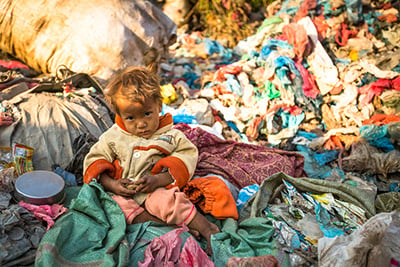
Inertization
The inertization process minimizes the risk of toxic materials spreading into surface water or groundwater by mixing the waste with cement and other substances before its disposal. This solution is particularly appropriate in the cases of pharmaceuticals and incineration ashes which have a high metal content (here the treatment is also known as “stabilization”).
Considering pharmaceutical waste, first the packaging is removed and then the pharmaceuticals are ground. A mixture of water, lime, and cement is added and a homogeneous mass results. This mass is cast into cubes (e.g. measuring 1m3) or pellets and then transported from the treatment facility to a storage site. The mixture containing the inert waste can also be transported to a landfill site while still in liquid form and poured into municipal waste.
Inertization is relatively inexpensive and it does not require particularly sophisticated technology, the essential equipment being a grinder or road roller for crushing the pharmaceuticals, cement, lime, and water to form the mixture, and a concrete mixer for blending the waste and the concrete mixture.
There is not one universal solution for the appropriate treatment and disposal of hazardous medical waste. The alternative selected must concentrate on making the smallest possible impact on human health and the environment, but in the majority of cases it will have to be a compromise dependent on local conditions.
4. Biomedical and hospital waste management: definition and purpose
- To reduce the risk of damage to healthcare personnel, the population, and the environment
- To reduce the amount of waste
- To ensure the segregated collection of waste
- To establish proper waste collection sites in medical departments and in hospitals
- To establish a proper in-house transportation route
- To recover waste to the greatest extent possible
- To dispose of waste in an environmentally and health-friendly way

5. How can the Celitron ISS (our own medical waste shredder) provide a solution for hazardous medical waste disposal?
The Celitron ISS steam sterilizer unit can be used for the disposal of infectious medical waste in hospitals, clinics and other healthcare institutions. Celitron’s compact hazardous medical waste solution, the Integrated Sterilizer and Shredder, is a steam sterilizer with an integrated shredder. It is designed for the on-site conversion of biohazard waste in hospitals and clinics and complies with EU and WHO recommendations.
5.1 Medical waste disposal: the WHO's recommendation
“Waste generated by healthcare activities includes a broad range of materials, from used needles and syringes to soiled dressings, body parts, diagnostic samples, blood, chemicals, pharmaceuticals, medical devices, and radioactive materials.
Poor management of medical waste potentially exposes healthcare workers, waste handlers, patients and the community at large to infection, toxic effects and injuries, and risks polluting the environment. It is essential that all medical waste materials are segregated at the point of generation, appropriately treated, and disposed of safely.”
(Source: http://www.who.int/topics/medical_waste/en/)
5.2 Medical waste shredding and steam sterilization within a single vessel
The shredding of solid medical waste before its sterilization is an indispensable step as:
- It increases the extensiveness of the contact between the waste and the disinfectant as it increases the surface area of the waste and eliminates enclosed spaces.
- It makes body parts unidentifiable, thus precluding adverse visual impact during disposal.
- It reduces the volume of waste by 70-80%.
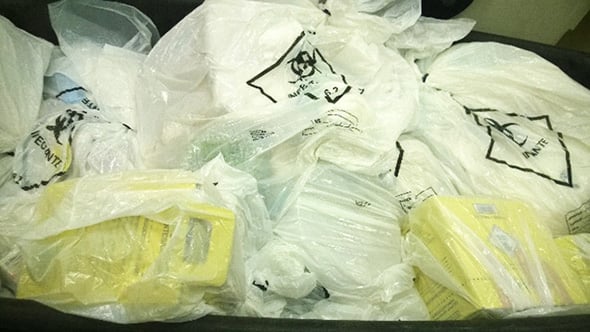
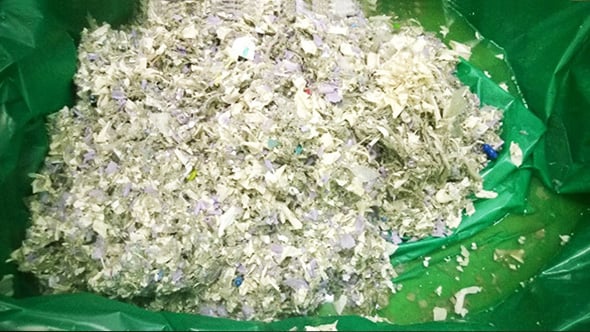
The ISS has a unique patented-technology knife block. With this special professional horizontal and vertical knife block, the shredding is perfect and thus the autoclaving process of the waste will be successful.
Autoclaving is a wet thermal treatment which is very efficient. Autoclaves are normally used to sterilize recyclable objects in hospitals, but such units can only treat smaller quantities of waste. Because of this they are most often used to treat only highly infectious waste such as microbial cultures and sharps. The advantages of autoclaving are:
- It is efficient and environmentally friendly.
- The technology is approved and permitted for infectious waste treatment in the majority of countries.
- It is simple for medical staff and the general public to understand and accept.
- By the exclusion of hazardous materials that can be isolated with selective collection, sterilization produces non-hazardous waste classifiable as municipal waste.
- In comparison with that of incineration, the capital investment cost of autoclaving is low.
The ISS performs both shredding and waste steam sterilization in a single vessel. The importance of this is essential during maintenance procedures, as it provides a safe working environment for both operators and technicians, and precludes the possibility of any cross-contamination.
The vessel is fitted with a motor-driven shaft and with powerful shredding / crushing blades which reduce the size and volume of the waste. The processed waste is rendered non-infectious, non-hazardous, and non-reusable; it is defined as non-regulated waste and can be discarded as normal municipal waste.
The Celitron unit enables hospitals, clinics, and other healthcare institutions to dispose of their selectively-collected infectious medical waste on site, without the waste leaving the institution.

5.3 Categories of biomedical waste handled by the ISS
MATERIALS HANDLED BY THE ISS:
- Syringes
- Dialyzers
- Scalpels
- Textiles
- Tests
- Plastic
- Glass
- Papers
- Organic materials
- Complete sharps containers
- Other hazardous biomedical waste
SERVES ANY INDUSTRY
- Dialysis clinics
- Hospitals
- Research facilities
- Surgical centers
- Plasma centers & blood banks
- Clinical laboratories
The range of hazardous wastes generated at healthcare institutions primarily suitable for treatment by the Integrated Sterilizer and Shredder (ISS) unit are assigned to EWC code 18 01 03 in the hazardous waste classification code system of the European Union, the designation of which is: "wastes whose collection and disposal is subject to special requirements in order to prevent infection." This includes wastes generated in healthcare institutions: from hospital beds, operating theatres, consulting rooms, and laboratories, the hazardous nature of which lies in their potential infection capability.
If collected with proper selectivity, only traces of chemical and drug residues may be present in infectious medical wastes (e.g. on cotton-wool swabs, tampons, infusion sets, syringes, etc.). In the case of these materials and instruments, in small quantities the infection hazard is more significant than the chemical hazard in small quantities, as the materials have been in contact with diseased human body surfaces, blood, and secretions. However, instruments, bottles and boxes containing larger quantities of chemicals, drug residues, or expired drugs must be collected separately as they require a different method of treatment.
Recommended treatment and selective collection for infectious (and potentially infectious) hazardous waste needles and sharps, including infusion, transfusion, and perfusion sets; butterfly needles; cannulas; disposable scalpel blades and razors; hemodialysis sets; laboratory slides; broken glass containers (bacteriological and clinical laboratories); ampoules containing solution residues, etc.
Recommended treatment for infectious (potentially infectious) hazardous waste materials other than needles and sharps, including: tampons, cotton wool balls, and paper wipes saturated with chemicals; plastic or paper waste containing chemical or drug residues; tampons, bandages, drains, probes, suture bits, and cotton wool swabs contaminated with blood and/or secretions; immobilizing plaster casts contaminated with blood and gauze strips contaminated with secretions; used rubber and foil gloves and rubber finger covers; emptied catheter bags, connection lines, catheters, etc.
5.4 Eco-friendly medical waste disposal thanks to the state-of-the-art nature of Celitron’s medical waste shredder (ISS)
As regards to the observance of environmental provisions, the Celitron ISS unit is an appropriate choice for healthcare institutions. By virtue of its size and capacity, most of the hazardous waste remains at its place of generation, i.e. on the premises of the specific institution. The shredded waste is reduced to as little as 1/5 its original volume, without emitting harmful substances and can be disposed safely as municipal waste.